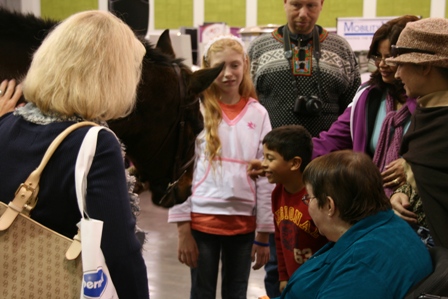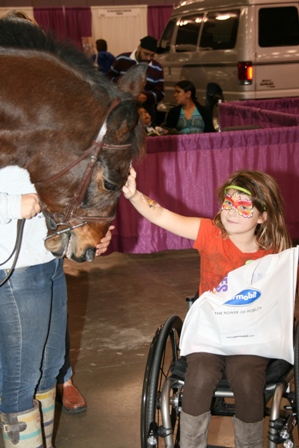Joell Dunlap, executive director of the Square Peg Foundation in Half Moon Bay, Calif., receives a lot of bold requests throughout the year, many of which she must turn down due to financial constraints or other limitations.
But when Rupert Issacson, creator of the Horse Boy Method, asked if she could bring horses into the San Jose Convention Center and do a demonstration for kids with autism at the Abilities Expo, she couldn’t resist.
Before I go any further, however, let me back up and tell you a little bit more about Square Peg and the Horse Boy Method. Dunlap founded Square Peg and received her non-profit status in 1994 with a goal of creating something in between a therapeutic riding center and a traditional riding center.
“We wanted to be an adaptive riding center for kids—no matter what challenge they had,” said Dunlap. “We wanted turn ‘I wish’ into ‘I can.’ That was our mission, so it was pretty simple. We also really wanted to be a landmark center for Thoroughbreds to really show the public what they can do.”
Rather than actively solicit for adoption, Dunlap decided to use Square Peg as a platform to highlight her horses’ talents. While some of the facility’s 14 Thoroughbreds horses have come off the track, Square Peg also has horses that are retired from successful show or polo careers.
The Horse Boy Method that Rupert Issacson asked Dunlap to demonstrate at the Abilities Expo is a series of different activities involving humans and horses that helps children and families with Autism to heal sensory dysfunctions and gain direct communication.

Rupert Issacson and Hank demonstrate the Horse Boy Method; photos courtesy of Abilities Expo
Issacson, who has an advanced riding background in fox hunting and eventing, turned to horses for help when his son was diagnosed with autism at age 2.
“His son made it really clear that horses were an important part of his life, and through a bunch of serendipity, (Issacson) realized horses, rhythm, motion, and nature are what got his son to start communicating verbally,” said Dunlap.
Issacson has spent the last five years experimenting with that concept. By using a lot of classical dressage techniques, he realized the rhythm of the horse was stimulating learning in his son’s brain.
“So rather than the traditional therapeutic riding approach, which would require a lot of walking and doing different tasks, he puts the kids in front of him in a big Western saddle,” said Issacson. “He does a lot of classical dressage work with his horses, and he’s able to walk, trot, and canter with these kids in his lap. So that’s what we’ve been working with here…he’s really blown away we can do (the Horse Boy Method) with Thoroughbreds.”

Rupert Issacson and Hank demonstrating a trick at the Horse Expo; photo by Farris Scott
One of aspect of the Horse Boy Method is trick training. According to the Horse Boy Foundation website, “Teaching a horse to do tricks in response to a one syllable command can be very useful in encouraging a child that is reluctant to speak, or on the cusp of becoming verbal to take that extra step.
“Tricks such as smile, bow, lay down, jambetts (presenting a front leg on command), working on a pedestal, or even some high school dressage movements taught as tricks …can give a child a great sense of empowerment.”
When Dunlap started trick training the horses at Square Peg in preparation for the Abilities Expo, she was amazed at which horses took to it immediately, namely an 8-year-old gelding by Broken Vow named My Cheatin Heart. Nicknamed “Hank,” he picked up the training without a hitch and wasn’t fazed by the pandemonium at the Abilities Expo.
“Hank has always been stellar, but he just really picked up on trick training,” said Dunlap. “Rupert actually came out and did a training (at Square Peg) a couple weeks after the event and he couldn’t believe what a bright, eager horse Hank is.”

Hank greets fans at the Abilities Expo
Dunlap has relationships with several trainers at California tracks that notify her when a Thoroughbred needs a home. She heard about Hank through his former trainer, Mark Glatt, who had raced the gelding at the now defunct Bay Meadows.
Most would call Hank a failure as a racehorse, considering he wasn’t even close to being on the board in any of his four starts. He retired with measly earnings of $1,600, which didn’t even surpass his $2,500 yearling auction price. But Hank simply had another calling in life.
Now, with the help of Dunlap, the gelding is making a huge difference in the lives of children with disabilities. I can’t imagine a more worthy vocation.

Hank at the Abilities Expo
“Thoroughbreds have so much more to offer than people give them credit for once they come off the track,” said Dunlap. “If you know how to feed them and know what they’re exercise requirements are, they can be really steady, amazing horses.”
Here is an excerpt from Dunlap’s blog about her Square Peg Thoroughbreds performing the Horse Boy Method at the Abilities Expo:
“Our Thoroughbreds not only performed, but they exceeded all expectations with their kindness and generosity (at the Abilities Expo). They were often surrounded by wheelchairs festooned with motors, ventilators, balloons and more. They watched scissor lifts raise machinery into the air around them, they smiled on cue, bowed for the crowd and let numerous children with struggles such as blindness, cerebral palsy, limb deformities and developmental challenges pet and massage them. They trusted us and they trusted the pesky rubber boots we put on their flinty hooves to minimize the slipping that would occur on the sleek show room floor. The crowd loved them and they basked in the adoration even when the clapping of hands scared them. They were ambassadors of freedom and strength and power to people to whom life has dealt a different hand.”
Dunlap said Thoroughbred Charities had told her that the Square Peg Foundation uses more Thoroughbreds than any therapeutic riding center program they’ve ever funded.
While there are still many miles to go on the Thoroughbred aftercare issue, Dunlap said she had been encouraged by the strides made in recent years by industry members.
“Having placed Thoroughbreds in homes for the last 20 years, I will say in the last 24 months, I’ve seen a shift of owners and trainers being more interested in aftercare, and I think that’s splendid,” said Dunlap. It’s really neat to see people in racing be more engaged than they’ve ever been.
“As a result, we’re starting to really garner support from people in the racing industry, because they’re excited about what we’re doing. That’s been an uphill battle…five years ago, they weren’t nearly as interested, but I feel like the tide is changing.”
For more information about the Square Peg Foundation, click here.
For more information about Horse Boy Method, click here.

Hank makes a new friend




